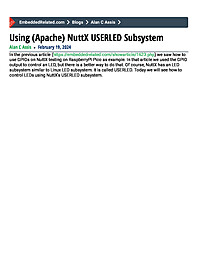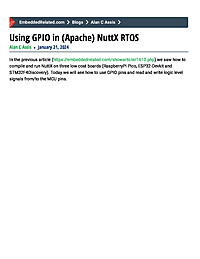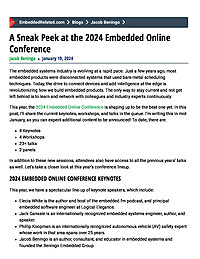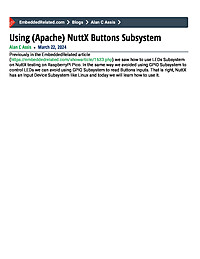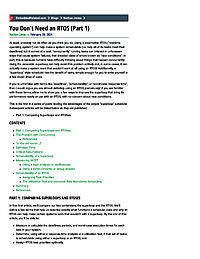
You Don't Need an RTOS (Part 1)
In this first article, we'll compare our two contenders, the superloop and the RTOS. We'll define a few terms that help us describe exactly what functions a scheduler does and why an RTOS can help make certain systems work that wouldn't with a superloop. By the end of this article, you'll be able to: - Measure or calculate the deadlines, periods, and worst-case execution times for each task in your system, - Determine, using either a response-time analysis or a utilization test, if that set of tasks is schedulable using either a superloop or an RTOS, and - Assign RTOS task priorities optimally.
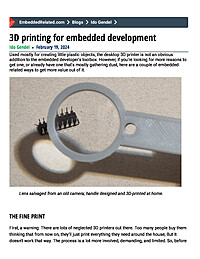
3D printing for embedded development
Used mostly for creating little plastic objects, the desktop 3D printer is not an obvious addition to the embedded developer's toolbox. However, if you're looking for more reasons to get one, or already have one that's mostly gathering dust, here are a couple of embedded-related ways to get more value out of it.
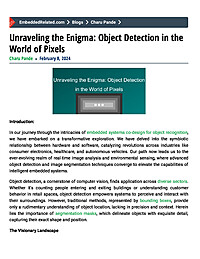
Unraveling the Enigma: Object Detection in the World of Pixels
Exploring the realm of embedded systems co-design for object recognition, this blog navigates the convergence of hardware and software in revolutionizing industries. Delving into real-time image analysis and environmental sensing, the discussion highlights advanced object detection and image segmentation techniques. With insights into Convolutional Neural Networks (CNNs) decoding pixel data and autonomously extracting features, the blog emphasizes their pivotal role in modern computer vision. Practical examples, including digit classification using TensorFlow and Keras on the MNIST dataset, underscore the power of CNNs. Through industry insights and visualization aids, the blog unveils a tapestry of innovation, charting a course towards seamless interaction between intelligent embedded systems and the world.
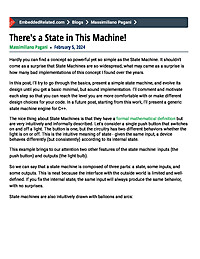
There's a State in This Machine!
An introduction to state machines and their implementation. Working from an intuitive definition of the state machine concept, we will start with a straightforward implementation then we evolve it into a more robust and engineered solution.
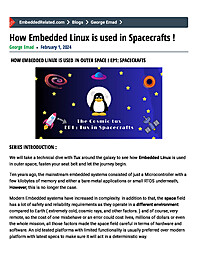
How Embedded Linux is used in Spacecrafts !
This article dives into the application of Linux in spacecraft, examining the challenges it poses and proposing potential solutions. Real-life examples will be discussed, while also addressing the drawbacks of employing Linux in safety-critical missions.
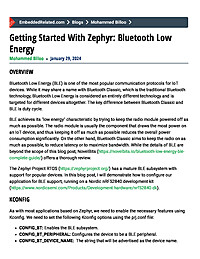
Getting Started With Zephyr: Bluetooth Low Energy
In this blog post, I show how to enable BLE support in a Zephyr application. First, I show the necessary configuration options in Kconfig. Then, I show how to use the Zephyr functions and macros to create a custom service and characteristic for a contrived application.
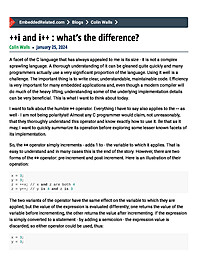
++i and i++ : what’s the difference?
Although the ++ and -- operators are well known, there are facets of their operation and implementation that are less familiar to many developers.
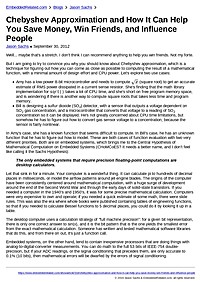
Chebyshev Approximation and How It Can Help You Save Money, Win Friends, and Influence People
Well... maybe that's a stretch. I don't think I can recommend anything to help you win friends. Not my forte. But I am going to try to convince you why you should know about Chebyshev approximation, which is a technique for figuring out how...
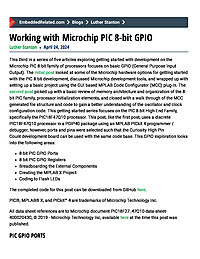
Working with Microchip PIC 8-bit GPIO
The third in a series of five posts looks at GPIO with PIC 8-bit microcontrollers. After a detailed review of the registers for configuring and managing GPIO on the PIC18F47Q10 processor, a basic application is stood up programming those registers to blink external LEDs at 0.5Hz.
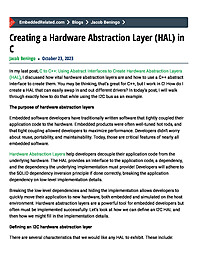
Creating a Hardware Abstraction Layer (HAL) in C
In my last post, C to C++: Using Abstract Interfaces to Create Hardware Abstraction Layers (HAL), I discussed how vital hardware abstraction layers are and how to use a C++ abstract interface to create them. You may be thinking, that’s great for C++, but I work in C! How do I create a HAL that can easily swap in and out different drivers? In today’s post, I will walk through exactly how to do that while using the I2C bus as an example.
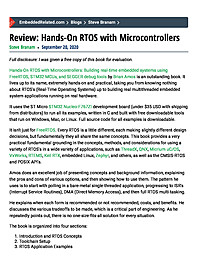
Review: Hands-On RTOS with Microcontrollers
Full disclosure: I was given a free copy of this book for evaluation.Hands-On RTOS with Microcontrollers: Building real-time embedded systems using FreeRTOS, STM32 MCUs, and SEGGER debug tools by Brian Amos is an outstanding book. It lives...
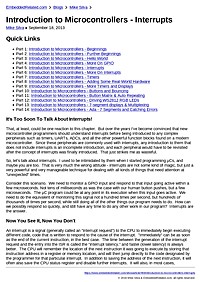
Introduction to Microcontrollers - Interrupts
[quicklinks] It's Too Soon To Talk About Interrupts! That, at least, could be one reaction to this chapter. But over the years I've become convinced that new microcontroller programmers should understand interrupts before being...
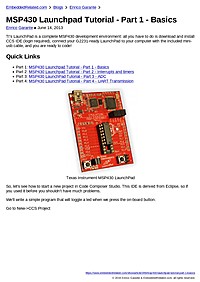
MSP430 Launchpad Tutorial - Part 1 - Basics
TI's LaunchPad is a complete MSP430 development environment: all you have to do is download and install CCS IDE (login required), connect your G2231-ready LaunchPad to your computer with the included mini-usb cable, and you are ready to...

A design non-methodology
Although writing an RTOS or kernel may be an interesting project, it is unlikely to be a wise course of action.
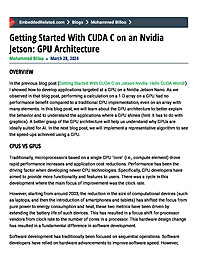
Getting Started With CUDA C on an Nvidia Jetson: GPU Architecture
In the previous blog post (Getting Started With CUDA C on Jetson Nvidia: Hello CUDA World!) I showed how to develop applications targeted at a GPU on a Nvidia Jetson Nano. As we observed in that blog post, performing a calculation on a 1-D array on a GPU had no performance benefit compared to a traditional CPU implementation, even on an array with many elements. In this blog post, we will learn about the GPU architecture to better explain the behavior and to understand the applications where a GPU shines (hint: it has to do with graphics).
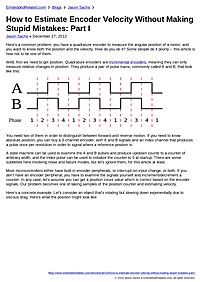
How to Estimate Encoder Velocity Without Making Stupid Mistakes: Part I
Here's a common problem: you have a quadrature encoder to measure the angular position of a motor, and you want to know both the position and the velocity. How do you do it? Some people do it poorly -- this article is how not to be one of...





